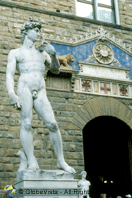
The Accademia di Belle Arti Firenze, or Academy of Beautiful Art of Florence, as it’s more formally known, is just what the name states: a school of art. And it’s true that students do study art here. They have since the Grand Duke of Tuscany, Pietro Leopold, gathered several schools under one roof in 1784. The roots of the school go back further, however, to the Academy of Art Design, founded in 1561. Yet, for visitors, it is the many art galleries that attract attention.
There is an extensive painting collection, with works ranging from the 13th through the 16th centuries. Not least are the 24 panels by Taddeo Gaddi depicting scenes from the life of Jesus. The Gallery also offers works by Uccello, Ghirlandaio, del Sarto and Botticelli. The Cassone Adimari, painted in the 1440s by Lo Scheggia, continues to attract a wide audience. Many of the paintings were collected for the specific purpose of providing the students with old masters to emulate and there are several here that serve that purpose well.
But, unquestionably, the works on display that attract the largest crowds are the busts and sculptures, and in particular Michelangelo’s David.
Off the end of the left-wing is a 19th-century hall with one wall that is festooned with plaster casts, busts and sculpture. Providing the students with many examples to follow, it will also be of interest to lovers of art who can but look, rather than create. The highlight here is the original plaster of the Rape of the Sabine Women by Giambologna. The completed marble piece is in the Loggia dei Lanzi.
Along the main hallway visitors encounter several unfinished works of the great master, Michelangelo. The Four Captives (or Slaves) provide a glimpse into the working technique of one of the greatest artists in history. Scholars have debated whether they truly were unfinished or intentionally left partially clad in stone with only certain features defined. But lovers of sculpture will simply stand in awe of what even a partial work of those hands of genius could display.
At the end, on a specially constructed platform called the tribune, stands the main attraction: David.
Made from a 16-foot piece of stone so oddly shaped that several other artists had abandoned it as impossible to work with, Michelangelo found in it good working material. From its depths he chipped, chiseled and polished one of the highest examples of three-dimensional art ever created.
Attacked in 1991 by a madman with a hammer who managed to damage several toes before being stopped, it now resides behind a Plexiglass barrier. But visitors will still get a very good view of the masterpiece when they can jostle their way sufficiently through the crowd. Moved from the Piazza del Signoria in 1873 to preserve it after four centuries in the sun and air, it offers a sample of the pinnacle of art in a city full of outstanding works. A copy now stands in its place.
Set atop a high pedestal, the more than life-sized statue is plainly visible. Viewers can easily pick out the ultra-lifelike muscles and veins. One can almost feel the warmth from a living being as David stands in a relaxed but alert pose, ready for battle. Finished in 1504 by an artist not yet 30 years old, it is justly the most famous piece of sculpture in the world.
